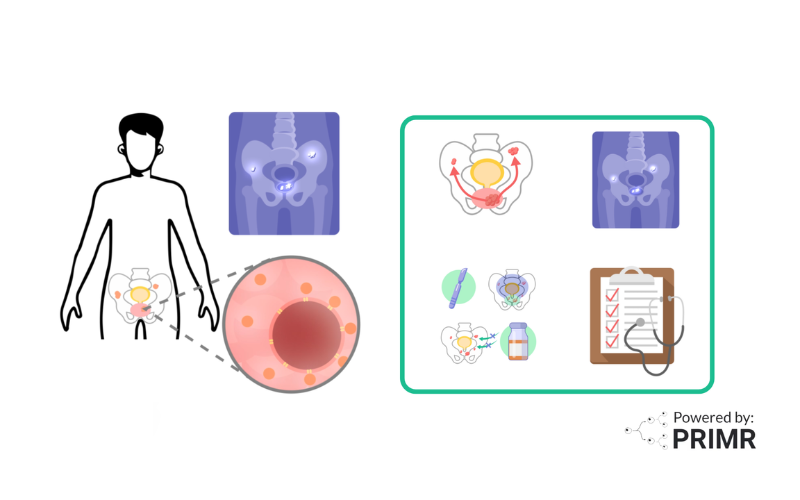Building Content for the “Visual Learner” Patient

By: David Grew MD MPH
“This is so helpful because I’ve always been a visual learner.” - real cancer patient, after watching PRIMR videos.
∗ ∗ ∗
We all have different ways of learning and retaining information. Some of us prefer to listen to lectures or read books, while others are more visual learners, relying on images and diagrams to make sense of new concepts. For visual learners who learn better from seeing objects than listening or reading, understanding medical information can be a challenge. This is what drives the “why” for PRIMR: our mission is to reduce patient stress and anxiety with simple visual first education.
I used to think that being a visual learner was somehow non-traditional. But research has shown that people remember visual information much better than verbal or written information. In fact, the brain processes visual information much faster than text or speech. This is because the brain is wired to process visual information more efficiently than other types of information. When we see an image or a video, our brains can quickly and easily make connections between the different pieces of information, making it easier to understand and remember.
In the field of medicine, understanding complex concepts and treatments can be overwhelming for patients, especially if they rely on visuals to make sense of new information. Unfortunately, many doctors and healthcare providers have severe time constraints with patients, and necessarily rely on verbal or written communication to transfer knowledge to their patients. These verbal only processes can lead to confusion and poor patient experience.
For visual learners, “verbal first” communication and instruction can be a major barrier to understanding and engaging with their healthcare. This knowledge gap can result in poor treatment outcomes, decreased patient satisfaction, and even medical errors.
We’re building PRIMR to serve as the patient education company that understands the importance of visual communication in healthcare. We saw firsthand the need for visual aides in every day patient care. Our mission is to create simple visuals with lay language narration for cancer and clinical trials, making it easier for patients to understand and engage with their healthcare journey.
PRIMR's approach is based on the science of visual learning, which shows that patients are more likely to understand and retain information when it is presented in a visual format.
For patients, we created a visual resource library to explore their disease, necessary tests, treatments and the latest clinical trials.
For enterprises, we offer co-branded licensing of our content library to bring PRIMR resources to the point of care in your clinic with a QR code driven experience.
And finally for research teams, we build custom content to help make their protocol come to life with color and animation. All content are IRB approved and can be easily implemented across enrolling sites with a simple QR code flier.
For interested readers: These references provide a comprehensive overview of the research on the science behind visual learning and how it can be applied to various fields, including education and medicine.
Paivio, A. (1971). Imagery and verbal processes. Holt, Rinehart and Winston.
Mayer, R. E., & Anderson, R. B. (1992). The instructive animation: Helping students build connections between words and pictures in multimedia learning. Journal of Educational Psychology, 84(4), 444–452.
Clark, R. C., & Mayer, R. E. (2016). E-learning and the science of instruction: Proven guidelines for consumers and designers of multimedia learning. John Wiley & Sons.
Kosslyn, S. M. (1980). Image and mind. Harvard University Press.
Tversky, B., Morrison, J. B., & Betrancourt, M. (2002). Animation: Can it facilitate? International Journal of Human-Computer Studies, 57(4), 247–262.
FAQs:
How does PRIMR ensure that its visual resources cater to the diverse learning needs of patients beyond just visual learners?
PRIMR incorporates a variety of visual elements and formats beyond just images and diagrams. PRIMR considers factors such as the selection of onscreen text and the simplicity of graphics to appeal to different learning styles. Even color is considered to ensure emphasis on important concepts. The writing of PRIMIR content in itself is meant to replicate how a physician would speak to their patient in clinic, which may or may not include visuals during the visit.
Can PRIMR's visual resources be customized to accommodate patients with different levels of medical knowledge or backgrounds?
Yes, these details are carefully considered with the help of patient advocacy groups and clinical trial teams in charge of the study. This customization could involve adjusting the complexity of the visuals, providing additional explanatory text, or offering translations into different languages.
What measures does PRIMR take to ensure its visual resources are accurate, up-to-date, and compliant with medical standards and regulations?
PRIMR has a rigorous process for maintaining excellence including in-house review by a board-certified physician, peer and patient advocate reviews, Institutional Review Board (IRB) in the US and independent ethics committee (IEC) review in the EU, as well as content updates based on protocol changes or study guidelines.
Other Posts

Nuclear Medicine: PSMA Treatment Explained from a Doctor’s Perspective

Nuclear Medicine: PSMA Imaging and Its Impact on Prostate Cancer Care
